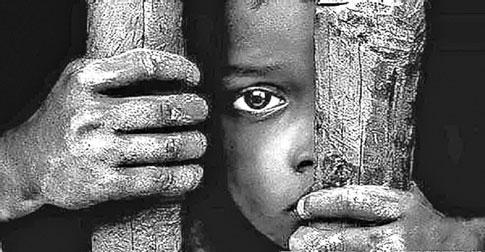Modern-day slavery still thriving
Despite being illegal, slavery is alive and thriving.
by IRIN
NAIROBI - More than two centuries after slavery was outlawed, 29.8
million people globally continue to be subjected to new and diverse
forms of servitude, a new index ranking 162 countries shows.
 Haiti, India, Nepal, Mauritania and Pakistan have the highest
prevalence of modern-day slavery, according to the first edition of the
Global Slavery Index (compiled by Australian-based rights organisation
Walk Free Foundation), while in absolute numbers, China, Ethiopia,
India, Nigeria and Pakistan have the most people enslaved. Haiti, India, Nepal, Mauritania and Pakistan have the highest
prevalence of modern-day slavery, according to the first edition of the
Global Slavery Index (compiled by Australian-based rights organisation
Walk Free Foundation), while in absolute numbers, China, Ethiopia,
India, Nigeria and Pakistan have the most people enslaved.
In India, almost 14 million people are believed to be victims of
modern slavery. Contemporary servitude, however, is “poorly understood,
so it remains hidden within houses, communities and worksites”, it
stated. According to the UN special rapporteur on contemporary forms of
slavery Gulnara Shahinian, its causes and consequences, “contemporary
slavery…often occurs in hard to reach areas of the country or what is
perceived as the 'private realm’, such as in the case of domestic
servitude…
“In today’s world, slavery takes many different forms: human
trafficking, forced labour, bonded labour, servitude… These people are
controlled and forced to work against their will and their dignity and
rights are denied.”
IRIN looks at some of the major forms of modern-day slavery.
Forced labour: The International Labour Organisation (ILO) considers
compulsory or forced labour any “work or service exacted from any person
under the threat of a penalty and for which the person has not offered
himself or herself voluntarily.”
Common forms of forced labour can be found in under-regulated or
labour-intensive industries, such as agriculture and fisheries,
construction, manufacturing, domestic work, and the sex industry. A 2013
ILO report, highlighted some of the brutal conditions under which people
are made to work in the fisheries industry. This category can apply to
multiple forms of slavery, with people being forced to work in a variety
of ways, often including the threat of violence or debt bondage.
ILO estimates that around 21 million people are victims of forced
labour. Debt bondage: This is the most common form of contemporary
slavery, according to the London-based NGO Anti-Slavery International,
which says “a person becomes a bonded labourer when their labour is
demanded as a means of repayment for a loan. The person is then tricked
or trapped into working for very little or no pay, often for seven days
a week.”
In Pakistan, the Asian Development Bank estimates that 1.8 million
people are bonded labourers, primarily working in brick kilns as well as
in agriculture, fisheries and mining. In Brazil’s rural sector, a 2010
UN report found that many poor workers were enticed to distant areas by
intermediaries, who charged an advance on their salaries, promising high
wages. The workers found themselves paying hefty off loans for the cost
of their transport and food, without any clear indication of how their
debt or wages were being calculated.
Similar practices occur in Bangladesh.
Human trafficking: The UN Convention Against Transnational Organised
Crime defines human trafficking as the “recruitment, transportation,
transfer, harbouring or receipt of persons”, through the threat or use
of force or other means of coercion “for the purpose of exploitation”.
In Benin, the International Office for Migration estimates that more
than 40,000 children are the victims of trafficking. The Global Slavery
Index notes that many of these children are trafficked to countries
within the region, as well as from rural to urban areas within one
country.
Forced or servile marriage: This occurs when an individual does not
enter into a marriage with full and free consent.
The 1956 Supplementary Convention on the Abolition of Slavery
considers illegal any practice where “a woman, without the right to
refuse, is promised or given in marriage on payment of a consideration
in money or in kind to her parents, guardian, family or any other person
or group”.
Transfer of a woman by her husband in return for payment, as well as
inheritance of a woman following the death of her husband, is also
outlawed. While the definition only applies to women and girls (who bear
the brunt of forced marriages) there have been calls for it to cover
boys and men too.
Child slavery: Child slavery and exploitation, including the use of
children in armed conflict, is another common form of contemporary
slavery. The Worst Forms of Child Labour, defined by ILO include the
sale and trafficking of children, compulsory labour, serfdom, and the
compulsory use of children in armed conflict.
In Haiti, children from rural households are sent to urban areas to
work as domestic house helps for wealthier families and can then be
exploited.
Around one in 10 children in Haiti are exploited, according to the
Global Slavery Index. While child slavery remains a significant problem,
the number in child labour around the world reduced to 168 million in
2012 from 246 million in 2000, according to ILO.
Chattel slavery: A situation where a person or group of people is
considered the property of a slave-owner, and can be traded, is the
least common form of slavery today. Slave-owners in these situations
control victims and their descendants, and therefore, individuals are
often born enslaved.
Although slavery was finally criminalised in Mauritania in 2007,
leading to the freeing of many people, few slave-owners have been
convicted of the practice, and chattel slavery remains a serious
problem.
The Global Slavery Index estimates there are 140,000-160,000 slaves
in Mauritania.
- Third World Network Features
|

